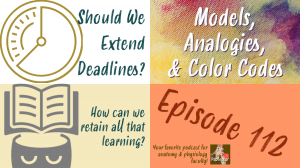Host Kevin Patton discusses the fact that many students hate histology. And perhaps even some faculty. Are there any ways to fix that? Kevin thinks he may have found a breakthrough idea.
00:00 | Introduction
01:20 | Sponsored by AAA
02:25 | Why Do Students Hate Histology?
16:27 | Sponsored by HAPI
17:06 | Birding For Tissues
39:15 | Sponsored by HAPS
40:14 | A Breakthrough
51:25 | Staying Connected
★ If you cannot see or activate the audio player, go to: theAPprofessor.org/podcast-episode-113.html
🏅 Apply for your credential (badge/certificate) for listening to this episode: theAPprofessor.org/podcast-episode-113.html/#badge
❓ Please take the anonymous survey: theAPprofessor.org/survey
☝️ Questions & Feedback: 1-833-LION-DEN (1-833-546-6336)
✔️ Follow The A&P Professor on Twitter, Facebook, Blogger, Revue, Tumblr, or Instagram! @theAPprofessor
📰 Get the thrice-weekly TAPP Science & Education Updates theAPprofessor.org/updates
“Thirty years ago my older brother, who was ten years old at the time, was trying to get a report written on birds that he'd had three months to write, which was due the next day. We were out at our family cabin in Bolinas, and he was at the kitchen table close to tears, surrounded by binder paper and pencils and unopened books about birds, immobilized by the hugeness of the task ahead. Then my father sat down beside him put his arm around my brother's shoulder, and said, "Bird by bird, buddy. Just take it bird by bird.” (Anne Lamott)
Sponsored by AAA
62 seconds
A searchable transcript for this episode, as well as the captioned audiogram of this episode, are sponsored by the American Association for Anatomy (AAA) at anatomy.org.
Don't forget—HAPS members get a deep discount on AAA membership!
Why Do Students Hate Histology?
14 minutes
Students often hate histology. At least they start off that way. Why is that? Maybe because histology is not simple. It's stratified.
★ The Storytelling Special | Episode 48
★ Playful & Serious Is the Perfect Combo for A&P | Episode 13
★ Jackson Pollock and His Paintings (the more you know, right?) AandP.info/3x0
Sponsored by HAPI Online Graduate Program
35 seconds
The Master of Science in Human Anatomy & Physiology Instruction—the MS-HAPI—is a graduate program for A&P teachers, especially for those who already have a graduate/professional degree. A combination of science courses (enough to qualify you to teach at the college level) and courses in contemporary instructional practice, this program helps you be your best in both on-campus and remote teaching. Kevin Patton is a faculty member in this program at Northeast College of Health Sciences. Check it out!
Birding For Tissues
22 minutes
One approach to making histology more interesting—and perhaps easier—is to share and teach our expert eye. As when learning to identify animals such as birds from an expert. We look at what that expert looks at. In birding, Peterson called these field marks. In histology, Kevin calls these landmark characteristics.
★ Peterson Field Guide to Birds (shows birds with field marks and range maps) geni.us/gvAP411
★ An Expert Derived Feedforward Histology Module Improves Pattern Recognition Efficiency in Novice Students (journal article from Anat Sci Educ) AandP.info/2tf
★ Eye tracking reveals expertise-related differences in the time-course of medical image inspection and diagnosis (journa article from J of Medical Imaging) AandP.info/y6f
★ AAA Histology Education Resources (includes links to virtual microscope, collections, etc.) AandP.info/npu
★ Field Guide to the Human Body (web page for students; has help using Kevin's "field guide" approach to learning tissues and other body structures) AandP.info/fieldguide
★ Finding Media | Images and More for Teaching Anatomy & Physiology (sources for histology images—and even Jackson Pollock paintings)
Sponsored by HAPS
36 seconds
The Human Anatomy & Physiology Society (HAPS) is a sponsor of this podcast. You can help appreciate their support by clicking the link below and checking out the many resources and benefits found there. Watch for virtual town hall meetings and upcoming regional meetings!
A Breakthrough
11 minutes
Using clickers in a kind of gamification strategy that leverages spaced retrieval practice, Kevin found that his students not only have fun, but also begged for more practice time!
★ Clickers (on-demand online seminar from The A&P Professor; digital credential available)
★ The clicker commandment I always violate (blog post on using clickers in the manner described in this segment) AandP.info/1q9
★ Revisiting Retrieval Practice | Episode 68
★ Desirable Difficulty | More Web Meeting Skills | TAPP 78
If the hyperlinks here are not active, go to TAPPradio.org to find the episode page.
★ More details at the episode page: theAPprofessor.org/podcast-episode-113.html
★ Transcript available in the transcript box: theAPprofessor.org/podcast-episode-113.html
★ Need help accessing resources locked behind a paywall? Check out this advice from Episode 32 to get what you need! my-ap.us/paywall
Take The A&P Professor experience to the next level!
★ theAPprofessor.org/community
Earn cash by referring other A&P faculty to this podcast:
Tools & Resources
★ TAPP Science & Education Updates: theAPprofessor.org/updates
★ Amazon: amzn.to/2r6Qa3J
★ Text Expander: theapprofessor.org/textexpander
★ Rev.com: try.rev.com/Cw2nZ
★ Snagit & Camtasia: techsmith.pxf.io/9MkPW
★ Krisp Free Noise-Cancelling App: theAPprofessor.org/krisp
★ JotForm (build forms for free): theAPprofessor.org/jotform
★ The A&P Professor Logo Items: https://www.teepublic.com/stores/the-a-p-professor
Sponsors
★ Transcript and captions for this episode are supported by the American Association for Anatomy | anatomy.org
★ The Human Anatomy & Physiology Society provides marketing support for this podcast | theAPprofessor.org/haps
★ Distribution of this episode is supported by the Northeast College of Health Sciences online graduate program in Human Anatomy & Physiology Instruction (HAPI) | northeast.edu/hapi
Clicking on sponsor links helps let them know you appreciate their support of this podcast!
Follow The A&P Professor on Twitter, Facebook, Blogger, Revue, Tumblr, or Instagram @theAPprofessor
The A&P Professor® and Lion Den® are registered trademarks of Lion Den Inc. (Kevin Patton)
As an Amazon Associate I earn from qualifying purchases. I may be compensated for links to sponsors and certain other links.
Click here to listen to this episode—or access the detailed notes and transcript.




